Last updated on October 31, 2023
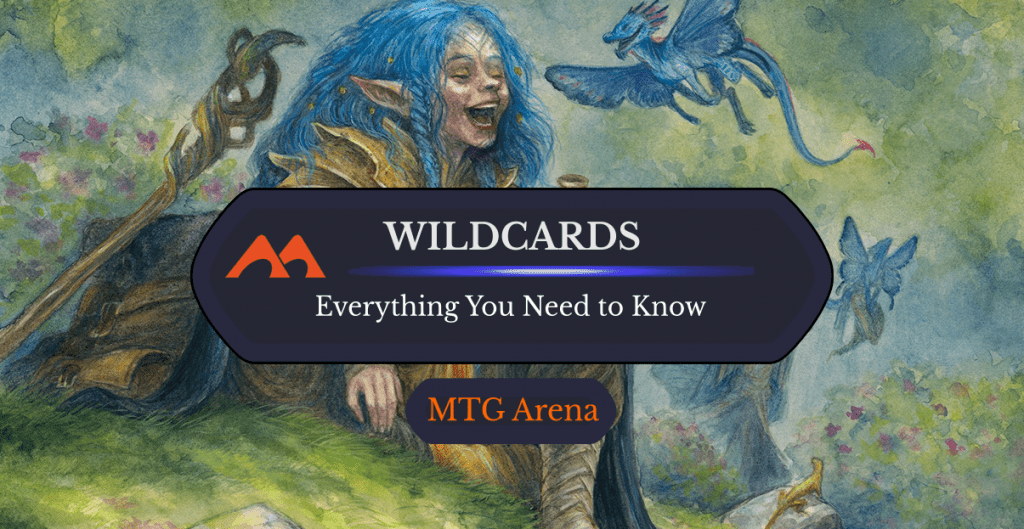
Feywild Trickster | Illustration by Iris Compiet
Are you new to MTG Arena? Do you ask yourself “what the heck are these wildcards I keep getting?” Are you building your first deck and want to know the best way to use these wildcards?
If you answered “yes” to any of these questions then you’re in luck! I'll be tackling everything from explaining what wildcards are and how you can get them to strategies on the best ways to use them, as well as a step-by-step walkthrough on how to redeem them.
We’ve got quite a bit of ground to cover, so buckle up and let’s get to it!
What are MTG Arena Wildcards?

Wildcards in MTG Arena are digital objects you can trade in or “craft” for any available card of the same rarity. This means that you can trade in a rare wildcard for any available rare card, an uncommon wildcard for any available uncommon card, etc.
As you can see above, these beautifully designed wildcards come in common, uncommon, rare, and mythic. Sounds familiar, doesn’t it?
If you’re familiar with them, wildcards are to MTG Arena what Arcane Dust is to Hearthstone. If that means nothing to you, then read on to find out more!
Can You Trade With Other Players in MTGA?
No. Wildcards were created to mimic the tabletop version of trading. MTGA doesn’t have an option to trade with other players. This is a big one that separates Arena from MTG Online and MTGA from IRL play which do offer trades. Wildcards are MTGA's way of making sure that you can still collect the cards that you need.
The entire MTG Arena business model and economy is predicated on the wildcard system detailed in this article, so don't hold out hope for Wizards to “implement trading” or “allow trading” some day. It's not going to happen.
How Many Wildcards Do I Have?
First, find the lotus icon on the top bar in your MTGA client, a bit right from center. Then hover over the icon with your cursor and a small pop-up will appear that shows you your wildcard inventory. Check out this quick demonstration video that we whipped up for you:
Well, now we’re up to speed on wildcards and how they work. Hooray! Let’s get to the important part: how you can get your hands on them. If you’re thinking “Psh, easy! All I’ll have to do is spend a little gold or gems and I’ll be set!”, well, think twice again.
Crafting: How to Redeem Wildcards in MTG Arena
Let’s say you have a bunch of wildcards saved up and you want to build a deck to play in MTGA. You’ve done a bunch of research and found the deck you want. This Golgari Food deck, for instance:
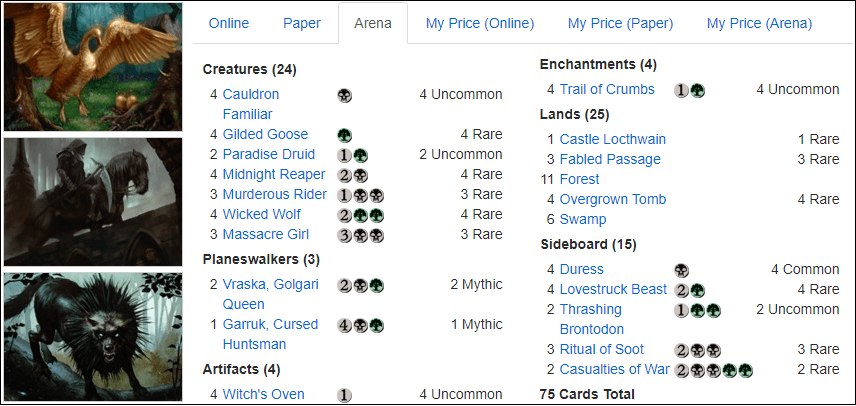
Method 1: Crafting in Bulk
Whatever deck you’ve settled on, here’s how to redeem wildcards if you're looking to craft in bulk:
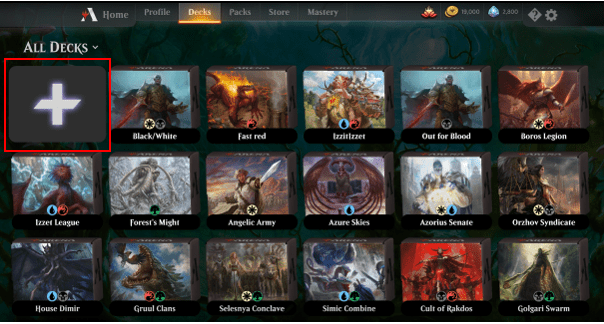
1. Open your “Decks” tab and then click on the white plus icon to start a new deck.

2. Before you do anything, click on the ‘Advanced Filters' button.
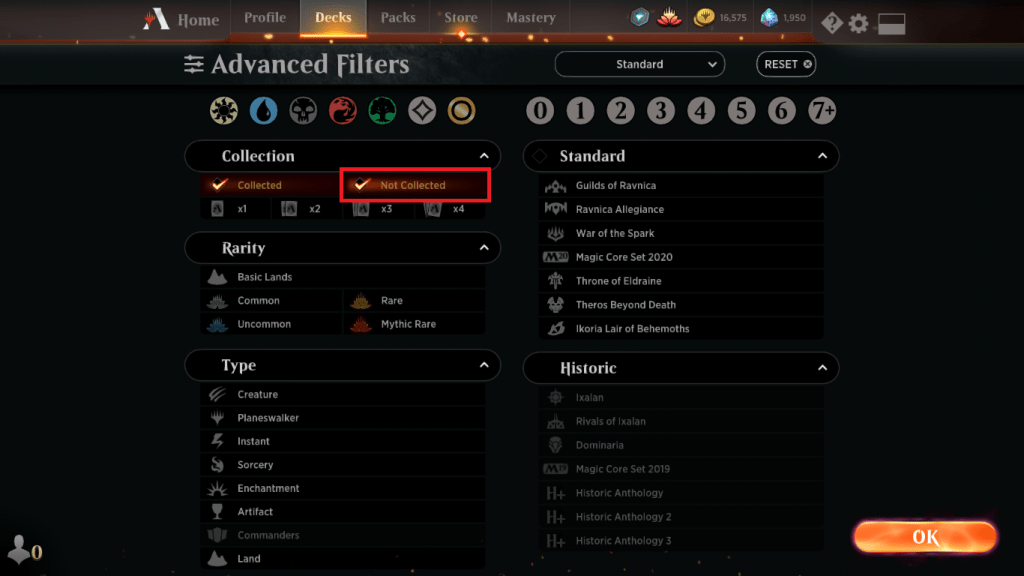
3. Check the “Not Collected” checkbox to ensure that cards you don’t have (and may want to craft using your wildcards) will appear and then click “OK.”

4. Select the format that you’re building your deck for.
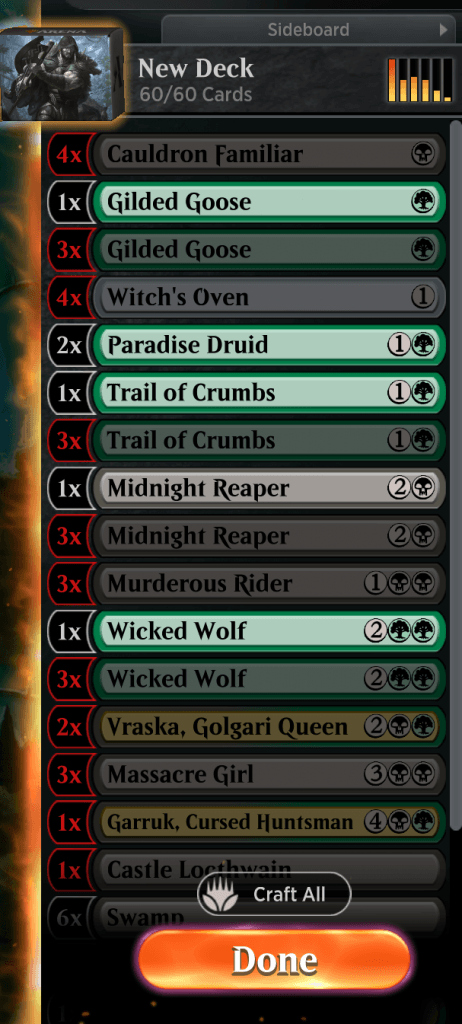
5. Add cards to your deck as you normally would until you've completed building your deck. Cards in white are owned, cards in red that are faded need to be crafted.
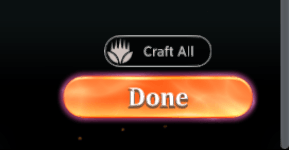
6. Click “Craft All” at the bottom of the decklist.
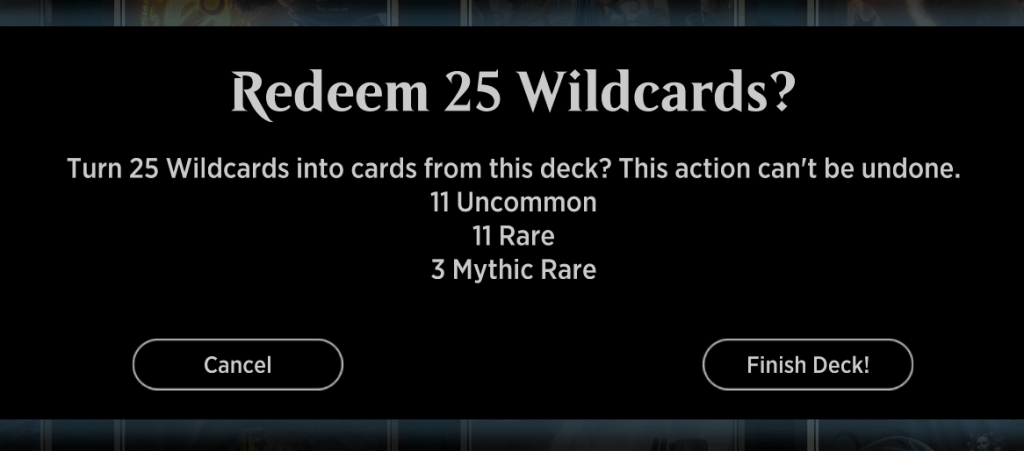
7. A pop-up will appear showing how many wildcards of each rarity it will take to craft your deck. Click “Finish Deck” to craft all the cards and complete your deck, or “Cancel” if you’ve changed your mind.
Method 2: Crafting Individual Cards in the Deck Builder
Here’s how to use wildcards in MTG Arena one by one if you're looking to craft individual cards that you don't own any copies of:

1. Open your “Decks” tab and then click on the white plus icon to start a new deck.
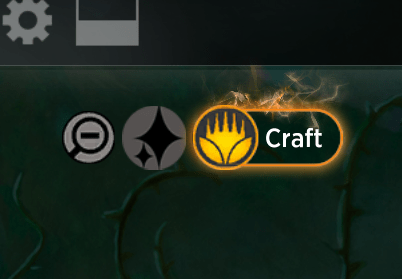
2. Click “Craft” at the top right of the main deck building screen.
3. Find the card you want to craft using the Search bar at the top left and then click on it.
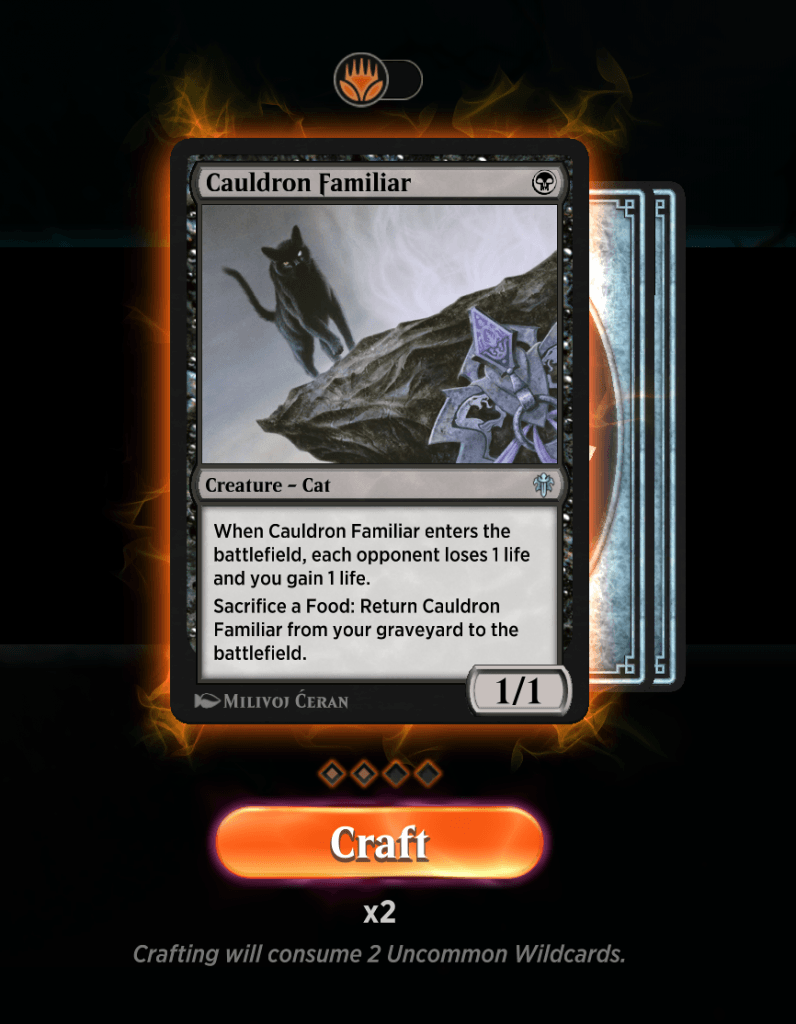
4. A pop-up will appear. Select how many of this card you want to craft using the icons directly below the card and then click “Craft.”
Method 3: Crafting Individual Cards in Your Collection
This option will work without having the ‘Craft' or ‘Not Collected' filters activated:

1. Open your “Decks” tab and then click on the “Collection” button at the bottom left of the screen.

2. Find the card you want to craft using the Search bar at the top left and then click on it. If you don't already own at least one copy of the card you want to craft, click “Craft” at the top right of the main deck building screen before you search for the card.
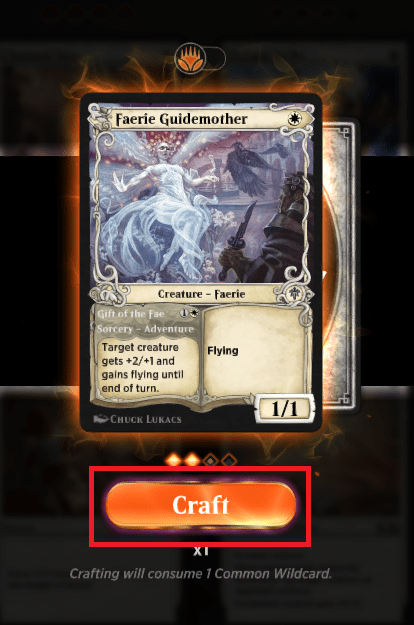
3. A pop-up will appear. Select how many of this card you want to craft using the icons directly below the card and then click “Craft.”
It’s important to note that you can’t craft beyond the number of wildcards you have available to you in each rarity (can you imagine, though?), so make sure to choose wisely when deciding on what deck or cards to craft. Conveniently, this segues nicely into the next topic to talk about: how to get the most value out of your wildcards.
How to Get Wildcards in MTG Arena

High Market | Illustration by Carl Critchlow
How do I get wildcards in MTG Arena, you ask? The best way to get wildcards is to open packs. And yes, technically you can spend your hard-earned gold buying those, but why buy packs when you can get them for free?
Earning and Opening Packs in MTGA
Getting Packs
Around every fifth match-win, you’ll have amassed enough XP to snag a free pack as a reward. You can take a look at our Mastery article for more info on level progress and level mastery. After a while, you win a pack for nearly every other level up.
Another way to earn free packs is by winning events and drafts. This will earn you both XP and packs, which makes it a double whammy. Before you know it, you’ll be raking in the packs by the bushel!
Another option (that you totally didn’t hear from us) is to use cheat promo codes. These will let you jump levels and get you packs from different sets available on MTG Arena. Check out our promo codes article for a list of all the latest codes for your viewing pleasure.
Opening Packs and Getting Wildcards
So, why are you trying to get all these packs, exactly? To put it simply, every time you open a pack there’s a chance that one (or several) of the cards will be a wildcard. They basically act as a substitute for a card from that pack in the equivalent rarity.
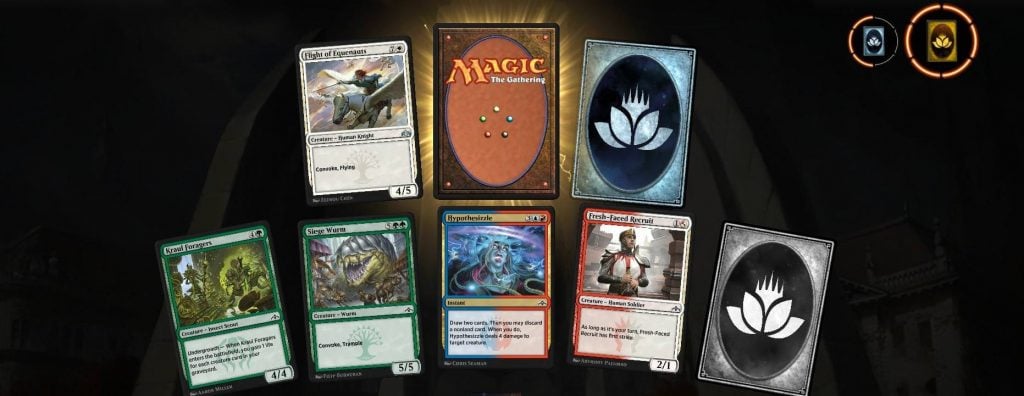
Every wildcard rarity has a specific chance attached to it of how often it will appear in packs. Kind of like a drop rate, except instead of killing a monster in a video game and picking up leveled loot, you’re opening a digital pack of cards in a simulated card game. The more packs you open, the faster you run through those chances, and the quicker you get wildcards!
Here’s a breakdown of how often you can expect to see wildcards in the packs you open along with the percent chance that you’ll see the associated rarity:
| Rarity | Drop Rate | % Chance |
| Common | 1:3 | 33.3% |
| Uncommon | 1:5 | 20% |
| Rare | 1:30 | 3.33% |
| Mythic Rare | 1:30 | 3.33% |
By this logic, you can puzzle out how many wildcards you can expect (probably) every time you open a pack if you keep track of every time you get one. Or, if you’re opening a bunch of packs, how many wildcards you’ll probably get by opening all of them.
How many rare wildcards from 45 packs in MTG Arena, I hear you ask? Well, let’s do the math. Don’t worry, it’s pretty simple. Since rare wildcards are expected to drop once every 30 packs opened, you’ll probably end up getting just the one with one mythic, nine uncommon, and 15 common wildcards. If you’re incredibly unlucky, though, don’t worry! There’s a system in place to help you.
Called the “pity timer”, every time you don’t get a wildcard of any rarity when opening a pack, the drop rates for that rarity will increase. Once you get a wildcard of the increased drop rate’s rarity, the drop rates go back to normal. This keeps probability—which can be a fickle, fickle thing—from keeping those coveted rare and mythic wildcards out of your hands because of a silly little thing like bad luck.
Advancing the Wildcard Wheel of Progression
OK, so opening lots of packs will inevitably get you some wildcards. But what if I told you that opening packs itself also gets you closer to earning wildcards through the wildcard Track? “The what?”, you ask. These beautiful things right here:

Every time you open a pack, a bar on each Track will light up until you’ve got six lit bars. At that point, you’ll get a wildcard of the associated rarity from the completed Track and it'll reset to zero.
The smaller of the two Tracks gives you uncommon wildcards every time it’s completed, while the bigger of the two Tracks alternates between giving you rare and mythic wildcards. You’ll get four rare wildcards the first four times you complete the Track and then it’ll switch and give you one mythic wildcard before restarting and cycling through again.
As a side note, MTG Arena draft packs do not count for wildcards. You won’t get wildcards in the packs and opening them doesn’t count towards the wildcard Track. The same goes for other limited formats like sealed.
Opening the “Vault”

There’s also the Vault to talk about. This one is also pretty simple: once you’ve collected four copies of a common or uncommon card, each extra one that you get will go into the Vault.
The Vault will open once you’ve gathered enough card duplicates and give you a reward in the form of three uncommon, two rare, and one mythic wildcard. Check out our article on the Vault if you want some more info on it and how to see your progress.
Buy A Wildcard Bundle
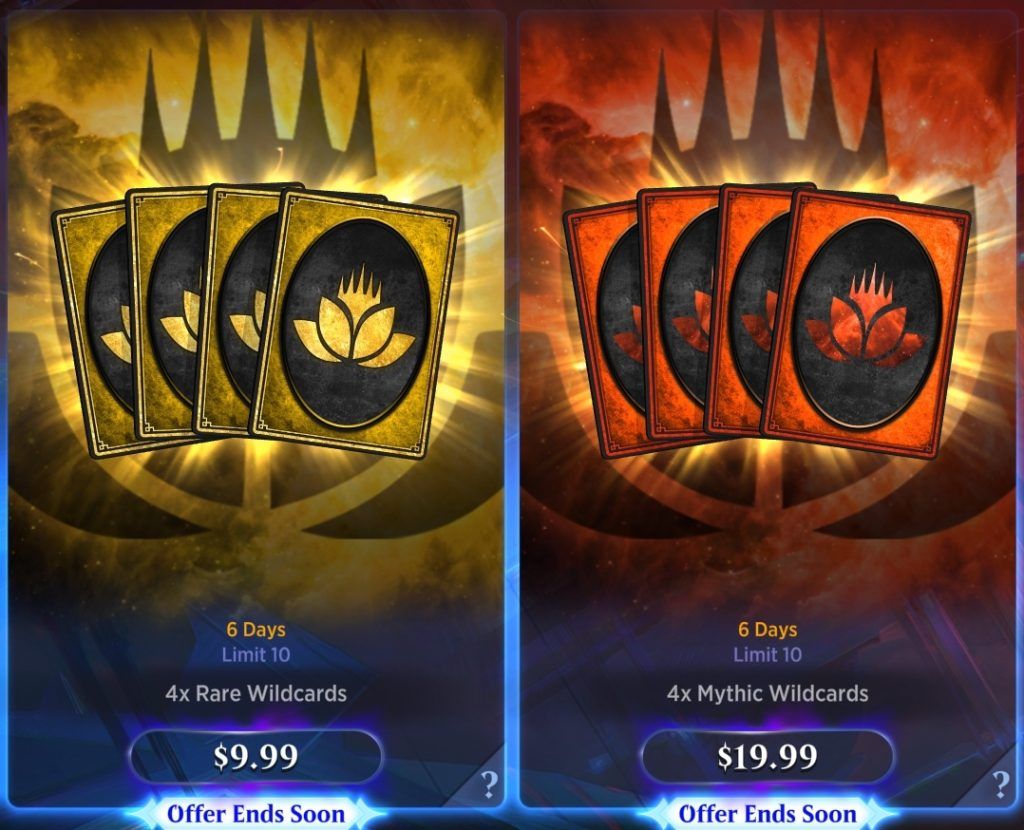
The Arena store-bought option was made in an attempt to help players who need wildcards specifically, and don't want to open an equivalent number of packs.
The two individual bundles are four rare wildcards for $9.99 and four mythic wildcards for $19.99. These are pretty expensive, especially for wildcards (which you tend to have more of).
If WotC is serious about giving players a workaround to getting our hands on more wildcards, they surely can come up with something better than this. I mean, at the very least, it could cost less and actually be good at what it's supposed to do.
Summing It All Up
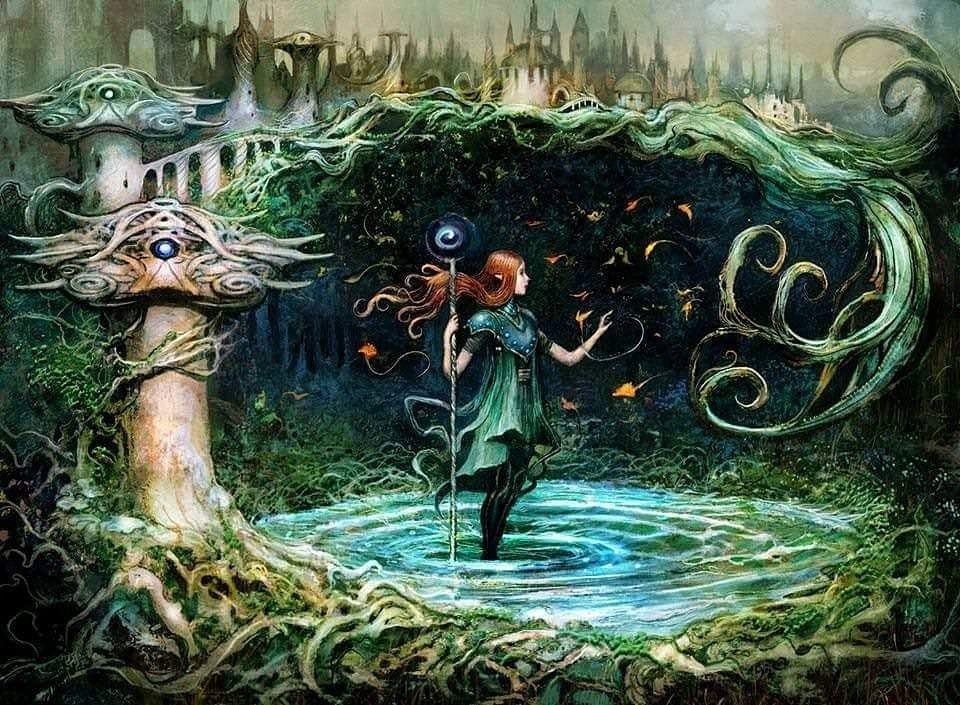
Growth Spiral | Illustration by Seb McKinnon
Here’s what we’ve gone over so far:
- Every pack you open (whether you buy them or collect them for free) has a chance to contain any rarity wildcard
- Every pack you open progresses the wildcard Track which gives you a wildcard every six packs opened
- All card duplicates after four copies go towards your Vault progress which gives you wildcards once full
Basically, the best way to get wildcards is to just open packs. It’s really that simple! Unfortunately, there isn’t really a fastest way to get rare wildcards in MTG Arena, short of getting as many packs as possible to open.
Can You Trade Up / Exchange Wildcards?
No, you cannot currently trade up any common or uncommon wildcards in exchange for rare or mythic wildcards. Many players have wondered if this would be a positive solution to the poor MTGA economy, but it seems as if that won't ever happen. In an economy discussion on March 17, 2022, the MTGA developers stated that they had no plans to ever include this mechanic in the game.
There are currently no plans to support this.
On The MTG Arena Economy
How to Use Your Wildcards in MTGA for Max Value
If you’re still new to MTGA, you’ve probably played a couple of games. You’ve unlocked the free precon decks, opened a few packs, and have seen a couple of wildcards go by. You might be asking yourself, what should I spend my wildcards on? It might be tempting to get a couple of new rares for that favorite pre-con that you like playing with so much.
Our advice is to stop that urge and don’t fall for that trap. As useful as pre-con decks can be when you’re just starting out, they’re not worth upgrading a ton. There are better decks out there that will stand their ground much better on the MTGA battlefield.
It pays to save up your wildcards until you know a good investment to use them on, like a top Standard deck. Here’s a bunch of pointers to help you get the most out of your wildcards:
- Don’t just trade-in for random cards: It might be tempting, but it doesn’t help your decks or progress. They might have some cool art or seem like a fun card, but if you can’t properly use it then it’s a waste of your wildcard.
- Use commons and uncommons to improve your pre-cons and get deck building experience: The common and Uncommon wildcards are the most abundant and the easiest to get, so try to tinker around with those to get some experience in deck building and crafting cards.
- Save up rare and mythic wildcards: Almost all Standard decks require a high number of rares and mythic, so saving wildcards up until you’re able to invest in one of those decks and get it in one go is well worth the wait.
- Prioritize rare and mythic (dual) lands: Any MTG deck gets a lot better when your land-base is good, and nothing helps that more than high-rarity dual lands, like shock lands or fetch lands. You can use them in all your decks, and they’ll last throughout the Standard period.
- Don’t invest in cards right after rotation: We know it’s tempting to get that crushing deck that jumps to the top of the meta right after rotation, but chances are that the format is still adjusting and it won’t last. Wait until things have settled down a bit before trading in your wildcards.
- If trading individual cards, trade-in for cards that can go in multiple decks: This is similar to the reason for rare and mythic dual lands. Go for cards that show up in a multitude of decks so that you can switch if you’re not happy with your choice. This way you won’t have wasted the wildcard and can still use the card you traded it for.
- Research the meta before committing to a deck: There are plenty of sites to help you make your choice of a good deck. These provide some data on which decks and cards are seeing play: MTGGoldfish.com, MTGArena.Pro, and MTGDecks.net.
- Don’t invest in cards that will be rotating out soon: You won’t be able to use cards in the current Standard or the two-year rotating Alchemy that will be illegal when the Fall set releases. It could be a bit of a waste for the coveted rare and mythic wildcards. It’s better to bide your time and wait until the new meta has settled.
With these pointers in mind, you’re well on your way to successfully navigating to great card and deck choices using your wildcards with little to no regrets. Which is exactly where you want to be, we imagine.
In the end, it’s all about having fun. If you get great kicks out of building goofy decks, then by all means throw all these pointers to the wind and have a blast! If you’re more about competitive play, then these guidelines will definitely be of service.
Note: Wildcards in Historic

Rona, Disciple of Gix | Illustration by Tommy Arnold
Wizards of the Coast describes it best here:
Historic is a non-rotating format where you build decks and play using cards in your collection from all sets currently available on Magic: The Gathering Arena as well as curated cards from across Magic's history.
WotC
At first, Wizards said that the trade-in cost would be 2:1. This would’ve meant that all Historic cards would cost two wildcards of the relevant rarity. You can imagine what happened next: Riot. About two weeks later, Wizards updated Historic correcting the trade-in for MTG Arena Historic wildcards to be the same as any rare-equivalent card, 1:1. This applies to cards that have rotated out of Standard, as well as any newly introduced Historic Anthology cards.
MTGA Bugs With Wildcards
When it comes to digital gaming, one thing that we always have to contend with is bugs and glitches. Some can actually turn out to be funny or entertaining, while others are just headaches to deal with. Luckily, the wildcard system has stayed pretty bug-free, but we did find one potential issue that you might run into.
Wildcard Trade-in Bug
A few players have had issues with the trade-in of wildcards not working. The animation would play when trading in wildcards, but the new card wouldn’t be added to their library. Thankfully, the wildcard also didn't disappear into the void. Small victories. The fix for this bug is easy, all you have to do is restart the client and try again and you should be golden.
If you do happen to run into any trouble when dealing with wildcards—or any other bug for that matter—you should report it to Wizards’ support site.
Wildcard Wind Down

Platinum Angel | Illustration by Brom
With that, we’ve given you all that we can on the topic of wildcards. Hopefully, the info was helpful to you and you’ve got a better sense of how to go about collecting and using these cards. If you want to see more ways to get new cards in MTGA.
Don’t forget to check out the blog for all our articles and our AI-assisted MTGA Tracker, Arena Tutor.
If you’d like to see more content like this article, consider becoming a Patron on Patreon as well. We very much appreciate your support because, without you, we couldn’t do what we love to do. See you next time in the wonderful world of Magic the Gathering!
Follow Draftsim for awesome articles and set updates: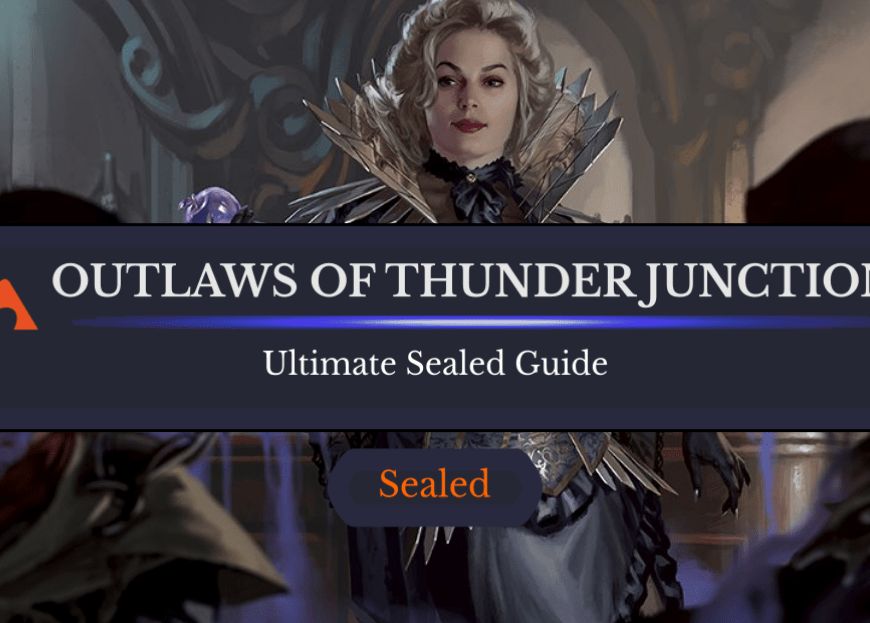

Add Comment